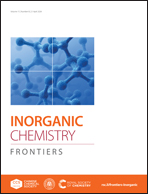Boosting structural variety and catalytic activity of porphyrinic metal–organic frameworks by harnessing bifunctional ligands†
Abstract
Due to the unique photophysical and electrochemical properties of porphyrins, porphyrin-based metal–organic frameworks (PMOFs) offer an excellent platform for heterogeneous catalysis applications and the fundamental study of structure–property relationships based on their crystalline nature. In this study, we investigate the impact of porphyrin ligands with different substituents on the structural diversity of derived Zr(IV)-based PMOFs (Zr-PMOFs), with a particular emphasis on the advantage of a bifunctional pyridyl-carboxylate porphyrinic ligand in tuning the structure and catalysis performance of resultant PMOFs. Two highly stable and porous Zr-PMOFs (BUT-229 and -230) prepared from the bifunctional porphyrinic ligand have similar constituents but different structural topology due to their ligands adopting different conformations. Noteworthily, the catalytic performance of Zr-PMOFs could be profoundly affected by the conformation of their porphyrinic ligands, which determines not only the topology, porosity, and catalytically active center density of the PMOFs, but also their photoelectric properties, including visible-light absorption, bandgap, electron transfer and charge separation efficiency. As a rare example of PMOFs with the flu topology, BUT-229 afforded obviously higher catalytic activity than BUT-230 as well as some benchmark PMOFs in the photo-oxidation reaction of benzyl alcohol. Moreover, with Lewis base sites (free pyridyl N atoms) on pore surfaces, BUT-229 could efficiently catalyze the tandem reactions between aromatic alcohols and active methylene compounds under mild conditions. Its catalytic activity was further enhanced by partially appending covalently the cocatalyst TEMPO (TEMPO = 2,2,6,6-tetramethylpiperidinooxy) to the free pyridyl groups via the Zincke reaction. These results provide insights into the development of high-performance porphyrin-based catalysts for tandem organic reactions.

- This article is part of the themed collection: 2024 Inorganic Chemistry Frontiers HOT articles


 Please wait while we load your content...
Please wait while we load your content...